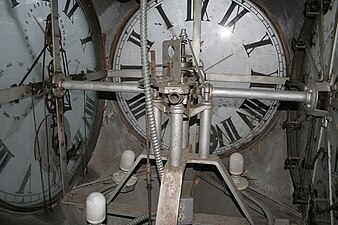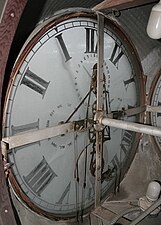
Buena Park is a city in northern Orange County, California, United States. As of the 2020 census its population was 84,034. It is the location of several tourist attractions, including Knott's Berry Farm. It is about 12 miles (19 km) northwest of downtown Santa Ana, the county seat, and is within the Los Angeles metropolitan area.
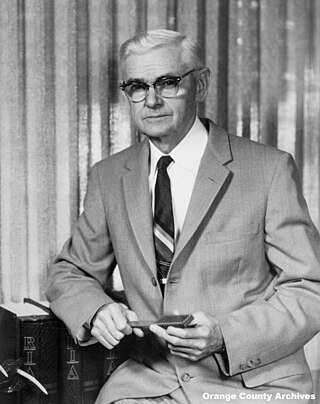
Walter Marvin Knott was an American farmer and businessman who founded the Knott's Berry Farm amusement park in Buena Park, California, introduced and mass-marketed the boysenberry, and founded the Knott's Berry Farm food brand.

Knott's Berry Farm is a 57-acre amusement park in Buena Park, California, United States, owned and operated by Six Flags. In March 2015, it was ranked as the twelfth-most-visited theme park in North America, while averaging approximately 4 million visitors per year. The park features over 40 rides, including roller coasters, family rides, dark rides, and water rides.

An automaton is a relatively self-operating machine, or control mechanism designed to automatically follow a sequence of operations, or respond to predetermined instructions. Some automata, such as bellstrikers in mechanical clocks, are designed to give the illusion to the casual observer that they are operating under their own power or will, like a mechanical robot. The term has long been commonly associated with automated puppets that resemble moving humans or animals, built to impress and/or to entertain people.

The Clock of the Long Now, also called the 10,000-year clock, is a mechanical clock under construction that is designed to keep time for 10,000 years. It is being built by the Long Now Foundation. A two-meter prototype is on display at the Science Museum in London. As of June 2018, two more prototypes are on display at The Long Now Museum & Store at Fort Mason Center in San Francisco.

In horology, a movement, also known as a caliber or calibre, is the mechanism of a watch or timepiece, as opposed to the case, which encloses and protects the movement, and the face, which displays the time. The term originated with mechanical timepieces, whose clockwork movements are made of many moving parts. The movement of a digital watch is more commonly known as a module.
Alabama Adventure & Splash Adventure is a water park and amusement park in Bessemer, Alabama. It is owned by Koch Family Parks, which consists of members of the family who formerly had minority ownership in Holiday World & Splashin' Safari.

State Route 39 is a state highway in the U.S. state of California that travels through Orange and Los Angeles counties. Its southern terminus is at Pacific Coast Highway, in Huntington Beach. SR 39's northern terminus is at Islip Saddle on Angeles Crest Highway in the Angeles National Forest, but its northernmost 4.5-mile (7.2 km) segment has been closed to public highway traffic since 1978 due to a massive mud and rockslide.

In horology, a complication is any feature of a timepiece beyond the display of hours, minutes and seconds. A timepiece indicating only hours, minutes and seconds is known as a simple movement. Common complications include date or day-of-the-week indicators, alarms, chronographs (stopwatches), and automatic winding mechanisms. Complications may be found in any clock, but they are most notable in mechanical watches where the small size makes them difficult to design and assemble. A typical date-display chronograph may have up to 250 parts, while a particularly complex watch may have a thousand or more parts. Watches with several complications are referred to as grandes complications.

Blair Field is a stadium in Long Beach, California. It originally opened in 1956 and is primarily used for baseball. It holds 3,238 people. It is named for Frank Blair, the sports editor for the Long Beach Press-Telegram newspaper for 32 years.

Buena Park station is a train station in Buena Park, California, United States, served by Metrolink commuter rail. It is at the center of a transit-oriented development including townhomes and a housing complex owned by the California State University, Fullerton, near the corner of Dale Street and Malvern Avenue. The station is served by Metrolink's Orange County Line and 91/Perris Valley Line.
Artesia Boulevard is a west-east thoroughfare in Los Angeles County and Orange County.

Knott's Scary Farm or Knott's Halloween Haunt is a seasonal Halloween event at Knott's Berry Farm in Buena Park, California. It is an event in which the theme park is transformed into "160 acres of horror", via a series of roaming monsters, terrifying haunted houses and 'scare zones'. As of 2010, it was said to be the first, largest and longest-running Halloween event to be held at a theme park.
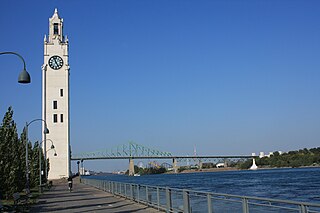
The Montreal Clock Tower, also known as the Sailor's Memorial Clock, is located in the borough of Ville-Marie and is situated in the Old Port of Montreal. The construction of the tower began in 1919, and was finished in 1922. The Clock Tower is 45 m (148 ft) tall with 192 steps from the bottom to the top of the tower. It has three observation stops along the staircase and the outside walls of the Clock Tower are white in colour. The structure consists of the principal tower as well as a smaller tower that is 12 m (39 ft) and architecturally similar to the main tower. The two towers are connected by a white 13 m (42 ft) curtain wall. The tower consists of four translucent clock faces. These are each 3.7 m (12 ft) in diameter and were designed by the English engineering firm Gillett & Johnston.
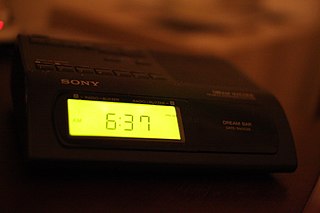
Sony Dream Machine was Sony's long-running line of clock radios. The line was introduced in the early 1960s and ran until the early 2010's.
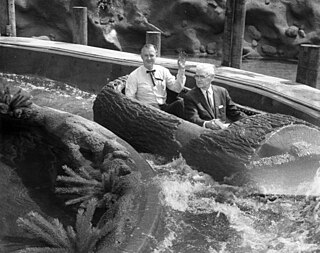
Wendell "Bud" Hurlbut was a designer, builder, entrepreneur, and one of the first creators of theme parks in the United States.
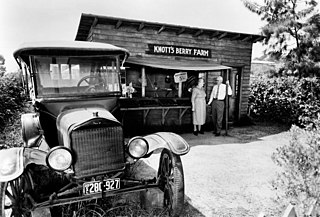
The Knott's Berry Farm amusement park in Orange County, California, originated from a berry farm owned by Walter Knott (1889–1981). In the 1920s, Knott and his wife, Cordelia, sold berries, berry preserves and pies from a roadside stand beside State Route 39, near the small town of Buena Park.

Marion Artemus "Bob" Speer (1885–1978) established the Western Trails Museum in 1936. He was a lifetime collector of Native American and Old West artifacts, and author. He built a building next to his house in Huntington Beach, California, to house his collection and opened it to the public. Twenty years later, he donated his collection to Knott’s Berry Farm, where it remains.


